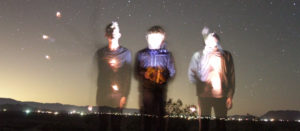strfkr banner 2
Being No One, Going Nowhere. The title of STRFKR’s fourth album may seem bleak
at first. But hold it in your head a minute, feel its weight, and you may recognize the
phrase for what it is: a goal. In the era of the personal brand—amid
the FOMO Age—it’s increasingly hard to shed a stifling sense of self, or to just be in
the moment that you’re in. Well, consider this an invitation to get blissfully
insignificant. That’s what STRFKR founder Joshua Hodges aimed to do when he
exiled himself to the desert to create this record, but he returned with his most
significant work yet: a set of darkly glistening dance songs rife with sticky beats,
earworming hooks, philosophical heft, and bittersweet beauty.
The album opens on “Tape Machine,” and the difference is readily apparent. On
2013’s Miracle Mile, STRFKR refined a full-band sound, but this doubles down on
and completely reimagines the project’s electronic and pop roots. The initial synths
could fuel a rave, and the ensuing groove could score a Drive sequel, but the song is
richer still, with cosmic effects flying overhead and a psych-folk earthiness below. It
isn’t that the band sat this LP out—drummer (etc.) Keil Corcoran penned the thick
astral disco of “In the End,” and he and bassist (etc.) Shawn Glassford both pitch in
throughout. But Being No One, Going Nowhere was born in Joshua Tree after
Hodges packed up his Los Angeles apartment and moved to that tiny Mojave outpost
under the great big sky. “It came together for me in the desert,” he says. “Out there,
it’s easy to feel small and slow.”
When Hodges started STRFKR in 2007, it was designed to be success-proof. The
name was both unfit for radio and a jab at fame-chasers. But the project was also
meant to be bright, playful and brimming with energy. He stumbled upon a winning
juxtaposition that’s a STRFKR staple to this day: dark (or heavy) lyrics set to happy
music. Hodges credits that to Elliott Smith’s influence, although Being No One, Going
Nowhere has closer sonic kin in Italo-disco, kosmische musik and Tony Hoffer’s
work with Phoenix, Beck and M83. English thinker/writer Alan Watts, a scholar of
Eastern philosophy, was another muse for Hodges—his voice appears on nearly
every STRFKR release, including this one. That’s him on “interspace,” talking about
sloughing off preconceived identity to find one’s place in the universe, which is the
story of Hodges’ eventual career: stop trying—no, start not trying—and succeed.
This album’s name actually paraphrases the title of a book by Ayya Khema, a
Buddhist nun, but the concept came to Hodges in a less chaste setting. “I had an
experience at a BDSM club that was really freeing,” he says. “I realized that the
appeal is letting go of your mind and stress. You can be super present with the pain,
and then the pain isn’t even pain. It’s a gateway to freedom.” In a way, each song on
Being No One, Going Nowhere seeks that end. There’s the reality-refracting fantasy
of “Never Ever,” the hard truths about addiction’s ravages on “Tape Machine,” a
death-defying coming of age tale on “Open Your Eyes,” and references to Hermann
Hesse’s 1919 novel of self-realization, Demian, on “When I’m With You.” If the words
don’t set you free, the music—exuberant, enveloping, incredibly catchy—should do
so handily.
None of which is to imply that STRFKR is drifting along aimlessly. To the contrary,
Hodges crafted this album’s dance bent with the stage in mind. The live setup these
days includes a custom-made LED wall and a homemade light show that syncs with
the rhythm of the songs (also, the occasional crowd-surfing astronaut and band-in-
drag). Plus, he camped out at the house of producer Jeffrey Brodsky (Yacht, RAC) for
a week and a half, working all hours to ensure Being No One, Going Nowhere sounds
as crisply booming over PAs as it does in headphones. Even if Hodges is too busy
pushing the future of indie dance-pop forward to possibly attain his goal of
unplugging, his aspiration is everything: “Existing is it. This moment is enough.”

